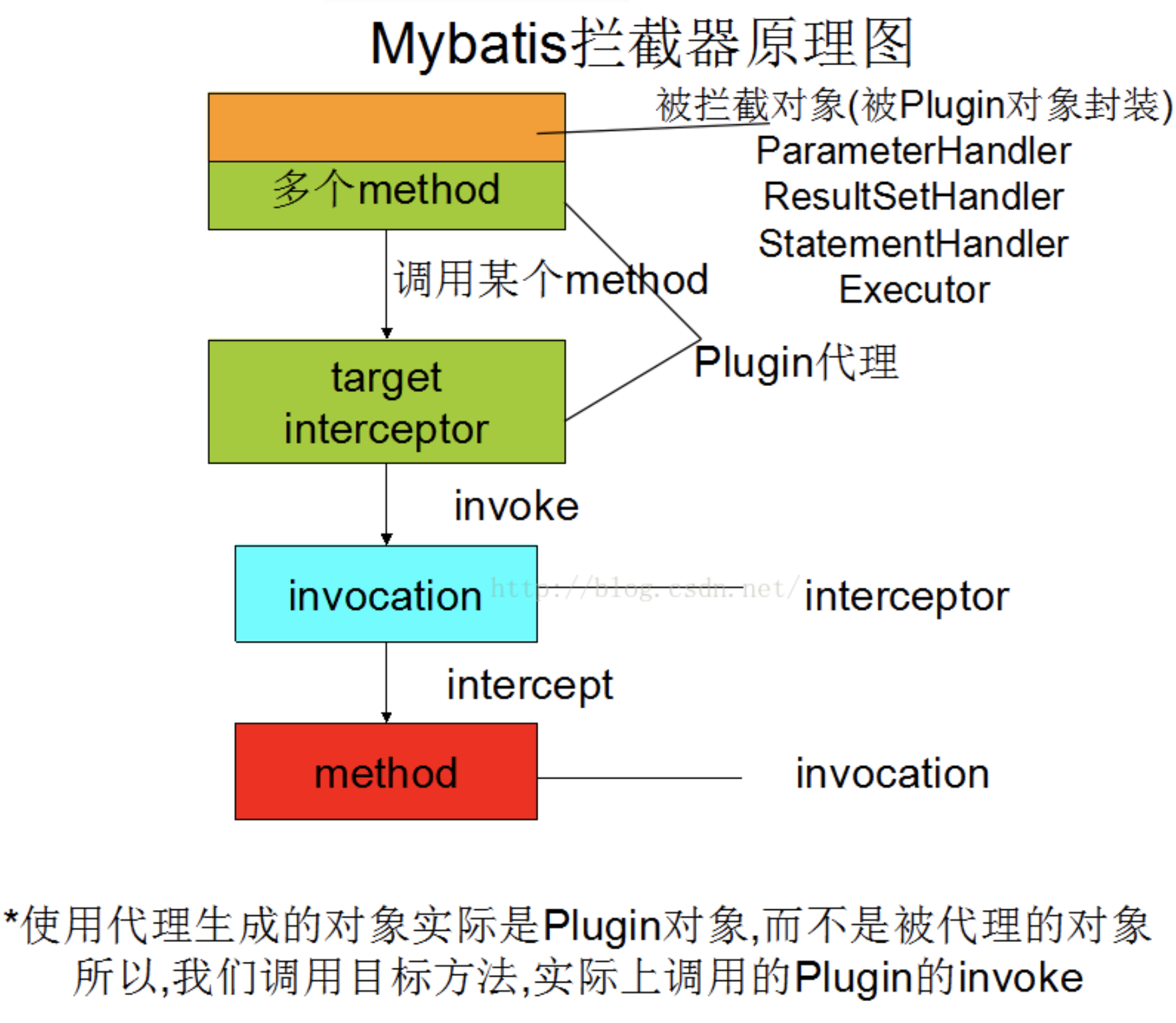一、概述
Mybatis采用责任链模式,通过动态代理组织多个插件(拦截器),通过这些插件可以改变Mybatis的默认行为(诸如SQL重写之类的)
Mybatis是通过动态代理的方式实现拦截的
拦截器(Interceptor)在 Mybatis 中被当做插件(plugin)对待,官方文档提供了 Executor(拦截执行器的方法),ParameterHandler(拦截参数的处理),ResultSetHandler(拦截结果集的处理),StatementHandler(拦截Sql语法构建的处理) 共4种,并且提示“这些类中方法的细节可以通过查看每个方法的签名来发现,或者直接查看 MyBatis 发行包中的源代码”。
拦截器的使用场景主要是更新数据库的通用字段,分库分表,加解密等的处理。
MyBatis提供了一种插件(plugin)的功能,虽然叫做插件,但其实这是拦截器功能。
MyBatis 允许你在已映射语句执行过程中的某一点进行拦截调用。默认情况下,MyBatis 允许使用插件来拦截的方法调用包括:
Executor (update, query, flushStatements, commit, rollback, getTransaction, close, isClosed):拦截执行器的方法
Mybatis的内部执行器,它负责调用StatementHandler操作数据库,并把结果集通过 ResultSetHandler进行自动映射,另外,他还处理了二级缓存的操作。从这里可以看出,我们也是可以通过插件来实现自定义的二级缓存的。
ParameterHandler (getParameterObject, setParameters):拦截参数的处理是Mybatis实现Sql入参设置的对象。插件可以改变我们Sql的参数默认设置。
ResultSetHandler (handleResultSets, handleOutputParameters):拦截结果集的处理是Mybatis把ResultSet集合映射成POJO的接口对象。我们可以定义插件对Mybatis的结果集自动映射进行修改。
StatementHandler (prepare, parameterize, batch, update, query):拦截Sql语法构建的处理是Mybatis直接和数据库执行sql脚本的对象。另外它也实现了Mybatis的一级缓存。这里,我们可以使用插件来实现对一级缓存的操作(禁用等等)。

Mybatis插件能够对这四大对象进行拦截,可以说包含到了Mybatis一次SQL执行的所有操作
二、 原理
Mybatis的拦截器实现机制,使用的是JDK的InvocationHandler.
当我们调用ParameterHandler,ResultSetHandler,StatementHandler,Executor的对象的时候,实际上使用的是Plugin这个代理类的对象,这个类实现了InvocationHandler接口
接下来我们就知道了,在调用上述被代理类的方法的时候,就会执行Plugin的invoke方法.
Plugin在invoke方法中根据@Intercepts的配置信息(方法名,参数等)动态判断是否需要拦截该方法.
再然后使用需要拦截的方法Method封装成Invocation,并调用Interceptor的proceed方法.
这样我们就达到了拦截目标方法的结果.
例如Executor的执行大概是这样的流程:
拦截器代理类对象->拦截器->目标方法
Executor->Plugin->Interceptor->Invocation
Executor.Method->Plugin.invoke->Interceptor.intercept->Invocation.proceed->method.invoke
2.1、拦截器接口
拦截器均需要实现该 org.apache.ibatis.plugin.Interceptor 接口
public interface Interceptor {Object intercept(Invocation invocation) throws Throwable;Object plugin(Object target);void setProperties(Properties properties);}
有3个方法。 MyBatis默认没有一个拦截器接口的实现类
setProperties方法是在Mybatis进行配置插件的时候可以配置自定义相关属性,即:接口实现对象的参数配置。
plugin方法是插件用于封装目标对象的,通过该方法我们可以返回目标对象本身,也可以返回一个它的代理,可以决定是否要进行拦截进而决定要返回一个什么样的目标对象,官方提供了示例:return Plugin.wrap(target, this)。
理解这个接口的定义,先要知道java动态代理机制。plugin接口即返回参数target对象(Executor/ParameterHandler/ResultSetHander/StatementHandler)的代理对象。在调用对应对象的接口的时候,可以进行拦截并处理。
intercept方法就是要进行拦截的时候要执行的方法。
2.2、拦截器四大接口实例
上述的Executor、ParameterHandler、ResultSetHandler、StatementHandler具体实现
2.2.1、实例创建
public Executor newExecutor(Transaction transaction, ExecutorType executorType) {//确保ExecutorType不为空(defaultExecutorType有可能为空)executorType = executorType == null ? defaultExecutorType : executorType;executorType = executorType == null ? ExecutorType.SIMPLE : executorType;Executor executor; if (ExecutorType.BATCH == executorType) {executor = new BatchExecutor(this, transaction);} else if (ExecutorType.REUSE == executorType) {executor = new ReuseExecutor(this, transaction);} else {executor = new SimpleExecutor(this, transaction);} if (cacheEnabled) {executor = new CachingExecutor(executor);}executor = (Executor) interceptorChain.pluginAll(executor);return executor;}public StatementHandler newStatementHandler(Executor executor, MappedStatement mappedStatement, Object parameterObject, RowBounds rowBounds, ResultHandler resultHandler, BoundSql boundSql) {StatementHandler statementHandler = new RoutingStatementHandler(executor, mappedStatement, parameterObject, rowBounds, resultHandler, boundSql);statementHandler = (StatementHandler) interceptorChain.pluginAll(statementHandler);return statementHandler;}public ParameterHandler newParameterHandler(MappedStatement mappedStatement, Object parameterObject, BoundSql boundSql) {ParameterHandler parameterHandler = mappedStatement.getLang().createParameterHandler(mappedStatement, parameterObject, boundSql);parameterHandler = (ParameterHandler) interceptorChain.pluginAll(parameterHandler);return parameterHandler;}public ResultSetHandler newResultSetHandler(Executor executor, MappedStatement mappedStatement, RowBounds rowBounds, ParameterHandler parameterHandler, ResultHandler resultHandler, BoundSql boundSql) {ResultSetHandler resultSetHandler = new DefaultResultSetHandler(executor, mappedStatement, parameterHandler, resultHandler, boundSql, rowBounds);resultSetHandler = (ResultSetHandler) interceptorChain.pluginAll(resultSetHandler);return resultSetHandler;}
查看源码可以发现, Mybatis框架在创建好这四大接口对象的实例后,都会调用InterceptorChain.pluginAll()方法。InterceptorChain对象是插件执行链对象,看源码就知道里面维护了Mybatis配置的所有插件(Interceptor)对象。
2.2.2、插件加载执行过程
1、plugin
target —> Executor/ParameterHandler/ResultSetHander/StatementHandler
public Object pluginAll(Object target) {for (Interceptor interceptor : interceptors) {target = interceptor.plugin(target);}return target;}
其实就是按顺序执行我们插件的plugin方法,一层一层返回我们原对象(Executor/ParameterHandler/ResultSetHander/StatementHandler)的代理对象。当我们调用四大接口的方法的时候,实际上是调用代理对象的相应方法,代理对象又会调用四大接口的实例。
Plugin对象
我们知道,官方推荐插件实现plugin方法为:Plugin.wrap(target, this);
2、wrap
public static Object wrap(Object target, Interceptor interceptor) {// 获取插件的Intercepts注解Map, Set> signatureMap = getSignatureMap(interceptor);Class<?> type = target.getClass();Class<?>[] interfaces = getAllInterfaces(type, signatureMap);if (interfaces.length > 0) {return Proxy.newProxyInstance(type.getClassLoader(), interfaces, new Plugin(target, interceptor, signatureMap));}return target;}
这个方法其实是Mybatis简化我们插件实现的工具方法。其实就是根据当前拦截的对象创建了一个动态代理对象。代理对象的InvocationHandler处理器为新建的Plugin对象。
3、插件配置注解@Intercepts
Mybatis的插件都要有Intercepts注解来指定要拦截哪个对象的哪个方法。我们知道,Plugin.warp方法会返回四大接口对象的代理对象(通过new Plugin()创建的IvocationHandler处理器),会拦截所有的执行方法。在代理对象执行对应方法的时候,会调用InvocationHandler处理器的invoke方法。Mybatis中利用了注解的方式配置指定拦截哪些方法。具体如下:
public Object invoke(Object proxy, Method method, Object[] args) throws Throwable {try {Set<Method> methods = signatureMap.get(method.getDeclaringClass());if (methods != null && methods.contains(method)) {return interceptor.intercept(new Invocation(target, method, args));}// 反射执行目标方法return method.invoke(target, args);} catch (Exception e) {throw ExceptionUtil.unwrapThrowable(e);}}
可以看到,只有通过Intercepts注解指定的方法才会执行我们自定义插件的intercept方法。未通过Intercepts注解指定的将不会执行我们的intercept方法。
4、官方插件开发方式
@Intercepts({@Signature(type = Executor.class, method = "query",args = {MappedStatement.class, Object.class, RowBounds.class, ResultHandler.class})})public class TestInterceptor implements Interceptor {public Object intercept(Invocation invocation) throws Throwable {Object target = invocation.getTarget(); //被代理对象Method method = invocation.getMethod(); //代理方法Object[] args = invocation.getArgs(); //方法参数// do something ...... 方法拦截前执行代码块Object result = invocation.proceed();// do something .......方法拦截后执行代码块return result;}public Object plugin(Object target) {return Plugin.wrap(target, this);}}
以上就是Mybatis官方推荐的插件实现的方法,通过Plugin对象创建被代理对象的动态代理对象。可以发现,Mybatis的插件开发还是很简单的。
自定义开发方式
Mybatis的插件开发通过内部提供的Plugin对象可以很简单的开发。只有理解了插件实现原理,对应不采用Plugin对象我们一样可以自己实现插件的开发。下面是我个人理解之后的自己实现的一种方式。
5、实例;
public class TestInterceptor implements Interceptor {public Object intercept(Invocation invocation) throws Throwable {Object target = invocation.getTarget(); //被代理对象Method method = invocation.getMethod(); //代理方法Object[] args = invocation.getArgs(); //方法参数// do something ...... 方法拦截前执行代码块Object result = invocation.proceed();// do something .......方法拦截后执行代码块return result;}public Object plugin(final Object target) {return Proxy.newProxyInstance(Interceptor.class.getClassLoader(), target.getClass().getInterfaces(), new InvocationHandler() {public Object invoke(Object proxy, Method method, Object[] args) throws Throwable {return intercept(new Invocation(target, method, args));}});}public void setProperties(Properties properties) {}}
当然,Mybatis插件的那这个时候Intercepts的注解起不到作用了。
6、小结
如果有N个插件,就有N个代理,每个代理都要执行上面的逻辑。这里面的层层代理要多次生成动态代理,是比较影响性能的。虽然能指定插件拦截的位置,但这个是在执行方法时动态判断,初始化的时候就是简单的把插件包装到了所有可以拦截的地方。
因此,在编写插件时需注意以下几个原则:
不编写不必要的插件;
实现plugin方法时判断一下目标类型,是本插件要拦截的对象才执行Plugin.wrap方法,否者直接返回目标本身,这样可以减少目标被代理的次数。
// 假如我们只要拦截Executor对象,那么我们应该这么做,默认是【return Plugin.wrap(target, this);】
@Overridepublic Object plugin(Object target) {if (target instanceof Executor) {return Plugin.wrap(target, this);} else {return target;}}
Mybatis插件很强大,可以对Mybatis框架进行很大的扩展。当然,如果你不理解Mybatis插件的原理,开发起来只能是模拟两可。在实际开发过程中,我们可以参考别人写的插件。下面是一个Mybatis分页的插件,可以为以后开发做参考。
每一个拦截器对目标类都进行一次代理,原对象如果是X,那么第一个拦截器代理后为P(X),第二个代理后P(P(X))……最后返回这样的多重代理对象并执行。所以先配置的拦截器会后执行,因为先配置的先被包装成代理对象。
最后在调用真实对象方法的时候,实际上是调用多重代理的invoke方法,当符合拦截条件的时候执行我们编写的interceptor.intercept,intercept方法最后必定是调用invocation.proceed,proceed也是一个method.invoke,促使拦截链往下进行,不符合拦截条件的时候直接调用method.invoke,即不执行我们的拦截方法,继续拦截链。
2.3、对象方法说明
2.3.1、Executor类说明
1、拦截器注解
@Intercepts({@Signature(type = Executor.class, method = "update", args = {MappedStatement.class, Object.class})})
拦截器的使用需要查看每一个type所提供的方法参数。
Signature 对应 Invocation 构造器,type 为 Invocation.Object,method 为 Invocation.Method,args 为 Invocation.Object[]。
method 对应的 update 包括了最常用的 insert/update/delete 三种操作,因此 update 本身无法直接判断sql为何种执行过程。
args 包含了其余所有的操作信息, 按数组进行存储, 不同的拦截方式有不同的参数顺序, 具体看type接口的方法签名, 然后根据签名解析。
2、Object 对象类型
args 参数列表中,Object.class 是特殊的对象类型。如果有数据库统一的实体 Entity 类,即包含表公共字段,比如创建、更新操作对象和时间的基类等,在编写代码时尽量依据该对象来操作,会简单很多。该对象的判断使用
Object parameter = invocation.getArgs()[1];if (parameter instanceof BaseEntity) {BaseEntity entity = (BaseEntity) parameter;}
即可,根据语句执行类型选择对应字段的赋值。
如果参数不是实体,而且具体的参数,那么 Mybatis 也做了一些处理,比如 @Param("name") String name 类型的参数,会被包装成 Map 接口的实现来处理,即使是原始的 Map 也是如此。使用
Object parameter = invocation.getArgs()[1];if (parameter instanceof Map) {Map map = (Map) parameter;}
即可,对具体统一的参数进行赋值。
3、SqlCommandType 命令类型Executor 提供的方法中,update 包含了 新增,修改和删除类型,无法直接区分,需要借助 MappedStatement 类的属性 SqlCommandType 来进行判断,该类包含了所有的操作类型
public enum SqlCommandType {UNKNOWN, INSERT, UPDATE, DELETE, SELECT, FLUSH;}
毕竟新增和修改的场景,有些参数是有区别的,比如创建时间和更新时间,update 时是无需兼顾创建时间字段的
MappedStatement ms = (MappedStatement) invocation.getArgs()[0];SqlCommandType commandType = ms.getSqlCommandType();


